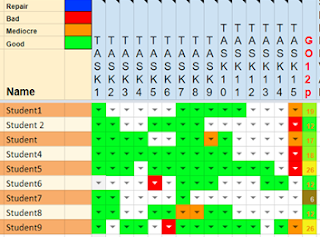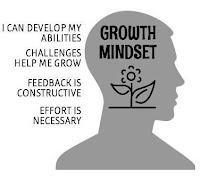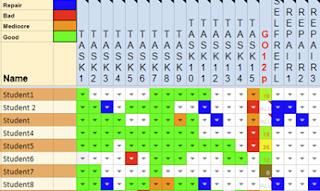
Freedom of choice is paramount and a big motivator, in all stages of life. For adults, and for students. Differentiated and personalized learning are hot topics within the present-day educational world. In this article a six-staged approach is presented which enables the teacher to offer his or her students the choice in learning paths, using data-driven feedback and meaningful coaching along the way.
The teacher gains a more profound view on the study choices and progress of his students. And the student will gain invaluable insight into his own learning process.
Choose
 The main objective of this learning format is to give the students the freedom to fill in their own personal learning path. The focus shifts towards a shared responsibility between teacher and student. The effect of choice on intrinsic motivation is clear and has been a subject of much academic research. This relation intensifies when children are examined [source 1]. The student is enabled to gain experience with different learning styles and equip himself with a useful choice of learning strategies.
The main objective of this learning format is to give the students the freedom to fill in their own personal learning path. The focus shifts towards a shared responsibility between teacher and student. The effect of choice on intrinsic motivation is clear and has been a subject of much academic research. This relation intensifies when children are examined [source 1]. The student is enabled to gain experience with different learning styles and equip himself with a useful choice of learning strategies.
Needed for this setup to work is a surplus of relevant tasks which differ from each other. In content and in learning style. For instance book exercises and digital tasks, experiments and literature studies. Start-up questions and formative tests at different stages of the process.
The teacher controls the level of freedom the students have in making their learning-related choices. Two or more strictly defined routes can be offered. The teacher can intensify the experience by introducing a system where students can build their own route from individual building blocks that are made available to them. By the use of a weighing system or other directives, the teacher can try and induce a desirable behavior. The most important hallmark is introducing a choice in learning style.
Work
 At the start of the term, the student chooses his or her preferred learning route. As the teacher will be playing a less dominant part in this process the chances of, on hindsight, an unfavourable choice will logically increase. Failing is a necessary part of learning and success in general. It is therefore important to lure the student outside his comfort zone. Where he can make leaps in his learning development. But there must always be the possibility of recovering from possible failure.
At the start of the term, the student chooses his or her preferred learning route. As the teacher will be playing a less dominant part in this process the chances of, on hindsight, an unfavourable choice will logically increase. Failing is a necessary part of learning and success in general. It is therefore important to lure the student outside his comfort zone. Where he can make leaps in his learning development. But there must always be the possibility of recovering from possible failure.
It is important that the student has the possibility to repair a disappointing learning result that originates from a ‘wrong’ choice of learning route. On the other hand, repair is only relevant when the student has shown commitment in making the best of this self-chosen route. You need first to build something before you are able to repair it. And to learn from the experience of failing. Therefore the student has to show working ethos. He has to earn the right to repair. To do this a so-called ‘dashboard’, where the activities of all the students during the term are registered, can be a very handy tool for the teacher. At the start of the term, the teacher communicates the criteria. Meeting these criteria automatically leads to a ‘go’ for a repair program later on.
Day to day practice: In the example below actual class results are shown at the end of the term. Educational platforms like Google G Suite enables the teacher to real-time communicate the dashboard with the students, via Classroom. This way heightening the transparency of the process as a whole. All possible tasks here were weighed. Students had access to extra information (weight factor, deadline, etc.) via the notes attached to each separate task. A total score of 12 points or more led to a ‘go’ for the repair program. In this example, no. 7 did not qualify for a repair program.
Here it was the teacher who monitors the administration. Giving the students the possibility (and trust) to fill in their progress themselves will raise the involvement in their own learning process even more. In view of privacy issues, it might be advisable to block the individual student names in the public dashboard and replace them with, for instance, their school registration numbers.
Test
It is the responsibility of the student to show a serious work ethos. To make the best of the learning path chosen. It is the teacher’s responsibility to offer the student a choice of high-quality learning tools with which successful completion of the task is within reach. And it is also the professional, the teacher, who makes high-quality tests. In the occurrence of a less than satisfying result, the student is eligible for a repair path, leading to a resit, assuming that the ‘go’ was earned earlier on.
“Don’t judge. Teach. It’s a learning process” Carol Dweck
Evaluate
This is the crucial stage of this learning format. Something has gone wrong in the learning process, leading to a negative result for the test. Now the teacher takes his responsibility and steps in to help the student. The process is evaluated, and as a result, the teacher composes a strictly personal repair plan for the student. The emphasis is on the learning attitude and methods used by the student and the will to learn from the mistakes made. To ask oneself ‘what can become better’, instead of the premature conclusion ‘’ you failed’.
The evaluation is fed from three sources, namely:
1. the analysis of the (summative) test, performed by the teacher. Where did the student falter? Which parts of the curriculum and which skills are not yet mastered? A valid analysis requires professional and well-thought tests and a strong test analysis tool.
2. the self-reflection, filled in by the student. What were the expectations beforehand? Which kind of errors were made repeatedly in the test? Where can the learning approach be improved?
3. the dashboard. Which tasks were chosen by the student, and what were the substantiations? Preferably, student and teacher discuss the choices made, and how this approach can be improved in the future.
“Data drives the decision, but humans make the decision” Khurram Virani, TED talk
In this stage, a platform like Google G Suite can be an invaluable help in the communication between teacher and student. The test analysis, valuable feedback of itself, can thus be shared with the student. The self-reflection can be in the form of a digital document that is shared, by the student, with the teacher.
Repair
From this evaluation, the teacher formulates a personal and defined repair plan. the aim here is to try and expose the student to other, and possibly more suitable, learning paths. Only after finishing all the tasks from the repair plan a resit can be taken.
Day to day practice: the use of resits is a hotly debated item within the educational field. When students fail a test the first time, just the offering of a resit alone will not suffice in enhancing the learning process. Chances are that the student also will fail the resit, or will pass but without learning anything from it, on a behavioral level. By imposing a repair plan the student is guided into a different, and possibly more promising, approach.
In the dashboard at the right three students were eligible for, and interested in, taking a resit. After the evaluation each of them was assigned additional tasks (the blue blocks), leading to a strictly personal repair program. These tasks can consist of previously unused tasks from the regular program, or additional tasks, fully aimed at repairing. The self-reflection always is a required task for a resit.
Resit
In contrast to the widespread habit that all students receive the universal right to resit a test or exam, this approach compels the student to make a serious effort. Twice, if a resit is desired. The deeper educational goal is to enable the student to take a successful step in his voyage of learning to learn. If the student is momentarily stuck, if he is not yet able to overcome this challenge, it is the mission of the teacher to use guidance and coaching to bend a possible setback into a valuable learning experience.
Conclusion
There are a number of advantages in applying this approach to your classroom routine :
– the student has an extrinsic motivational goal to work hard, namely the possibility to acquire a backup plan
– the student has more control over his learning process and becomes more intrinsically motivated
– resits become more successful and meaningful
– the teacher gains insight into the learning paths taken by his students
– the teacher is able to give more meaningful feedback
– the teacher’s role as a coach will gain prominence
And last, but not least
– the student is able to learn from his mistakes and has the possibility to work on his learning skills
There are some attention points when this method is brought into action. The repair stage will ask quite some effort from the student. It is advisable to intelligently place the repair stage in the curriculum calendar. So that there will be no interfering with your lesson plans in the following term, or those of your colleagues. It is also important to mention that the implementation will inevitably lead to an extra workload for the teacher where it concerns the monitoring of the students and the associated administration.
Epilogue
Day to day practice: After one school year of working with this approach students (16-17 y) from two classes took part in a survey on the effects of this new approach on their learning attitude. Some results:
Student responses:
“It was nice that we got freedom and responsibility”
“Lots of possibilities to learn the subject matter in different ways”
“The offering of learning routes gave me the possibility to choose for myself. That makes this subject fun, and we could use our time more effectively”
Literature source:
[1]: The Effects of Choice on Intrinsic Motivation and Related Outcomes: A Meta-Analysis of Research Findings, Erika A. Patall et. al., Psycological Bulletin 2008, Vol. 134, no, 2, 270-300












